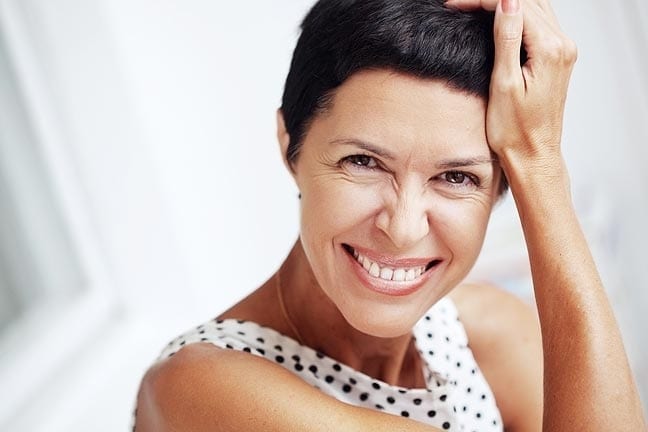Strong teeth and bones. In the same way that high cheekbones provide solid structure for your face, a set of full teeth and a strong bite can provide age-defying facial support by maintaining the upside-down “triangle of youth” into older age, says Waldorf. With the passage of time or less-than-auspicious genes, teeth can wear down to a shorter length and move inwards, resulting in a sunken look, thinner lips and more wrinkling around the mouth and cheek area. Straight, square-shaped teeth will maintain a sharper jawline as you age, providing uplifting support for facial features. Strong bones perform the same support structure for the body, with diseases like osteoporosis and anorexia rapidly accelerating age. “Keep your bones healthy with weight-bearing exercises and eat a calcium-rich diet to look younger longer,” advises Waldorf.
Thick hair. Flowing, thick locks of hair have long been an evolutionary signal of health, as a well-nourished body and diet rich in nutrients like biotin are necessary to grow a crowning head of hair. And as such, we subconsciously view hair as a signal of vitality, or lack thereof. “People with thinning hair look older than people of the same age who have thicker hair,” observes Downie. And if you look to politics, adds Downie, Americans haven’t voted for a bald candidate since incumbent Dwight D. Eisenhower in 1956, when he campaigned against fellow bald contender, Adlai Stevenson, perhaps suggesting that too much perceived age can render you unelectable. After all, it was John F. Kennedy— his youthful hairline and dashing tan symbolic of his progressive agenda—who arose from the first televised presidential debate against the more tenured Richard Nixon.
QUIZ: Are You Eating for Beautiful Hair & Skin?
Facial symmetry. “Genetic facial patterns play a huge role in determining the overall pattern of aging,” says Omaha, Nebraska dermatologist, Dr. Joel Schlessinger, who points to even facial portions and features as key to aging more slowly. Facial symmetry has long been identified with standards of beauty, and the reason finds its roots deep in evolutionary psychology. “Left-right symmetry in growing embryos requires very close control on each side to keep them in sync,” says Ian Stewart, Ph.D., author of Why Beauty Is Truth: The History of Symmetry. As babies develop in the womb and through childhood, stressors such as toxins, disease and emotional trauma can affect symmetrical growth. As a result, adults with higher facial symmetry show a strong resistance to stressors they may have encountered growing up. Time and gravity can also cause sagging, pigmentation and wrinkling that emphasizes asymmetries in the face, making the complexion look less and less even with passing years. So if you begin with strong symmetry, the marks of age will take longer to look apparent on your face
.QUIZ: Is Your Face Symmetrical?
Olive-to-darker skintone. The greater amount of melanin in deeper skintones can preserve the youth of your skin longer– but there’s a catch: “You burn more easily with lighter skin, which can potentially give you more fine lines, wrinkles and sun damage later on,” says Downie. “If you take care of your darker skin, it’s an advantage to you as you age, but if you don’t wear sunscreen, you’re no better off.” This caveat is illustrated by skin cancer statistics in African Americans, which comprise a rare one to two percent of all cancers in this group, yet the death rate is most fatal, since many assume natural protection, and aren’t diagnosed until it’s too late. Today, according to the Skin Cancer Foundation, the melanoma survival rate for African Americans is 77 percent, as compared to 91 percent for Caucasians.




































